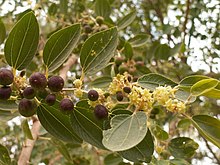Ziziphus spina-christi: Difference between revisions
citation for synonym; unhiding clarifying part of name |
Cyberbot II (talk | contribs) Rescuing 1 sources, flagging 0 as dead, and archiving 5 sources. #IABot |
||
| Line 23: | Line 23: | ||
'''''Ziziphus spina-christi''''', the '''Christ's Thorn Jujube''', is an evergreen tree native to northern and tropical Africa and southern and [[Western Asia]]. It grows in [[Palestine (region)|Palestine (Israel)]] in valleys up to an elevation of 500m.<ref>Zohary M. Flora Palaestina. II. Jerusalem: The Israel Academy of Science and Humanities; 1972. pp. 307–308 cited in {{citation|title=The ethnobotany of Christ's Thorn Jujube (Ziziphus spina-christi) in Israel|author=Amots Dafni, Shay Levy, and Efraim Lev|pmc=1277088 | pmid=16270941|doi=10.1186/1746-4269-1-8}}</ref> By some traditions, it was the tree from which Jesus' [[Crown of Thorns]] was made.<ref>{{cite web|url=http://www.flowersinisrael.com/Ziziphusspina-christi_page.htm |title=Ziziphus spina-christi |publisher=Flowersinisrael.com |date= |accessdate=2015-03-09}}</ref> |
'''''Ziziphus spina-christi''''', the '''Christ's Thorn Jujube''', is an evergreen tree native to northern and tropical Africa and southern and [[Western Asia]]. It grows in [[Palestine (region)|Palestine (Israel)]] in valleys up to an elevation of 500m.<ref>Zohary M. Flora Palaestina. II. Jerusalem: The Israel Academy of Science and Humanities; 1972. pp. 307–308 cited in {{citation|title=The ethnobotany of Christ's Thorn Jujube (Ziziphus spina-christi) in Israel|author=Amots Dafni, Shay Levy, and Efraim Lev|pmc=1277088 | pmid=16270941|doi=10.1186/1746-4269-1-8}}</ref> By some traditions, it was the tree from which Jesus' [[Crown of Thorns]] was made.<ref>{{cite web|url=http://www.flowersinisrael.com/Ziziphusspina-christi_page.htm |title=Ziziphus spina-christi |publisher=Flowersinisrael.com |date= |accessdate=2015-03-09}}</ref> |
||
The ripe fruits are edible,<ref name="eden-foundation">{{cite web|url=http://www.eden-foundation.org/project/articles_nutritionzizspina.html|title=Nutritional study on Ziziphus spina-christi|author=|publisher=Eden-foundation.org|accessdate=2014-06-11}}</ref> and the flowers are an important source of honey in [[Eritrea]] and [[Yemen]].<ref>[http://www.beesfordevelopment.org/info/info/flora/christs-thorn-ziziphus-sp.shtml ]{{ |
The ripe fruits are edible,<ref name="eden-foundation">{{cite web|url=http://www.eden-foundation.org/project/articles_nutritionzizspina.html|title=Nutritional study on Ziziphus spina-christi|author=|publisher=Eden-foundation.org|accessdate=2014-06-11}}</ref> and the flowers are an important source of honey in [[Eritrea]] and [[Yemen]].<ref>[http://www.beesfordevelopment.org/info/info/flora/christs-thorn-ziziphus-sp.shtml ] {{wayback|url=http://www.beesfordevelopment.org/info/info/flora/christs-thorn-ziziphus-sp.shtml |date=20100424201940 }}</ref> |
||
==Cultural and religious references== |
==Cultural and religious references== |
||
Revision as of 20:43, 31 January 2016
| Ziziphus spina-christi | |
|---|---|

| |
| Scientific classification | |
| Kingdom: | |
| (unranked): | |
| (unranked): | |
| (unranked): | |
| Order: | |
| Family: | |
| Genus: | |
| Species: | Z. spina-christi
|
| Binomial name | |
| Ziziphus spina-christi (L.) Desf.
| |
| Synonyms[1] | |
| |
Ziziphus spina-christi, the Christ's Thorn Jujube, is an evergreen tree native to northern and tropical Africa and southern and Western Asia. It grows in Palestine (Israel) in valleys up to an elevation of 500m.[2] By some traditions, it was the tree from which Jesus' Crown of Thorns was made.[3]
The ripe fruits are edible,[4] and the flowers are an important source of honey in Eritrea and Yemen.[5]
Cultural and religious references
In Palestine a hundred years ago it was called sidr (associated with the "Lote-trees" of the Koran) and was common in the Jordan valley and around Jerusalem.[6] There were some folklore traditions that said the trees were protected by benevolent spirits or dead saints (weli). The bedouin valued the fruit, calling it nabk. It could be dried and kept for winter or made into a paste which was used as bread. In Jerusalem Z. spina-christi crowns were sold to pilgrims.[7]
Elsewhere in the Arab world the Ziziphus lotus and Jujube are also associated with the Lote-trees (sidr).[8][9]
The nineteenth century English explorer, Richard Francis Burton reported seeing an ancient sidr tree in the mosque containing the Prophet Muhammad's tomb in Medina. It was in a garden dedicated to the prophet's daughter, Fatimah. The fruit from the tree was being sold to pilgrims and its leaves used for washing dead bodies.[10]
References
- ^ The Plant List: A Working List of All Plant Species, retrieved 30 January 2016
- ^ Zohary M. Flora Palaestina. II. Jerusalem: The Israel Academy of Science and Humanities; 1972. pp. 307–308 cited in Amots Dafni, Shay Levy, and Efraim Lev, The ethnobotany of Christ's Thorn Jujube (Ziziphus spina-christi) in Israel, doi:10.1186/1746-4269-1-8, PMC 1277088, PMID 16270941
{{citation}}: CS1 maint: multiple names: authors list (link) CS1 maint: unflagged free DOI (link) - ^ "Ziziphus spina-christi". Flowersinisrael.com. Retrieved 2015-03-09.
- ^ "Nutritional study on Ziziphus spina-christi". Eden-foundation.org. Retrieved 2014-06-11.
- ^ [1] Template:Wayback
- ^ Easton, M.G., M.A., D.D. (1893). Illustrated Bible Dictionary and Treasury of Biblical History, Biography, Geography, Doctrine, and Literature: With Numerous Illustrations and Important Chronological Tables and Maps. London, Edinburgh and New York: T. Nelson and Sons. p. 688.
«It overruns a great part of the Jordan valley.» p.174. Easton argues that the spina-christi is too brittle to be bent into a crown. He suggests another local plant which he says is called «nabk».
{{cite book}}: CS1 maint: multiple names: authors list (link) - ^ Crowfoot, M. Grace with Louise Baldenserger (1932) From Cedar to Hyssop. A study in the Folklore of Plants in Palestine. The Sheldon Press, London. pp.112,113
- ^ Abdullah, Yusuf Ali (1946) The Holy Qur-an. Text, Translation and Commentary, Qatar National Printing Press.p.1139,n.3814
- ^ Stephen Lambden. "The Sidrah (Lote-Tree) and the Sidrat al-Muntaha (Lote-Tree of the Extremity): Some Apects of their Islamic and Bābī-Bahā'ī Iintepretations". Retrieved 9 December 2015.
This is apparently the wild jujube or zizyphus spina-christi (Christ's thorn), a tall, stout, tropical tree (see image above) with dense prickly branches which produces a sweet reddish fruit similar to that of the jujube (the `unnāb = zizyphus vulgaris / fruit)
- ^ Burton, Sir Richard Francis (1855) A Personal Narrative of a Pilgrimage to Al-Madinah and Meccah p.337
External links
- The ethnobotany of Christ's Thorn Jujube (Ziziphus spina-christi) in Israel
- Thorns of Ziziphus spina-christi
- Flowers in Israel - Ziziphus spina-christi
